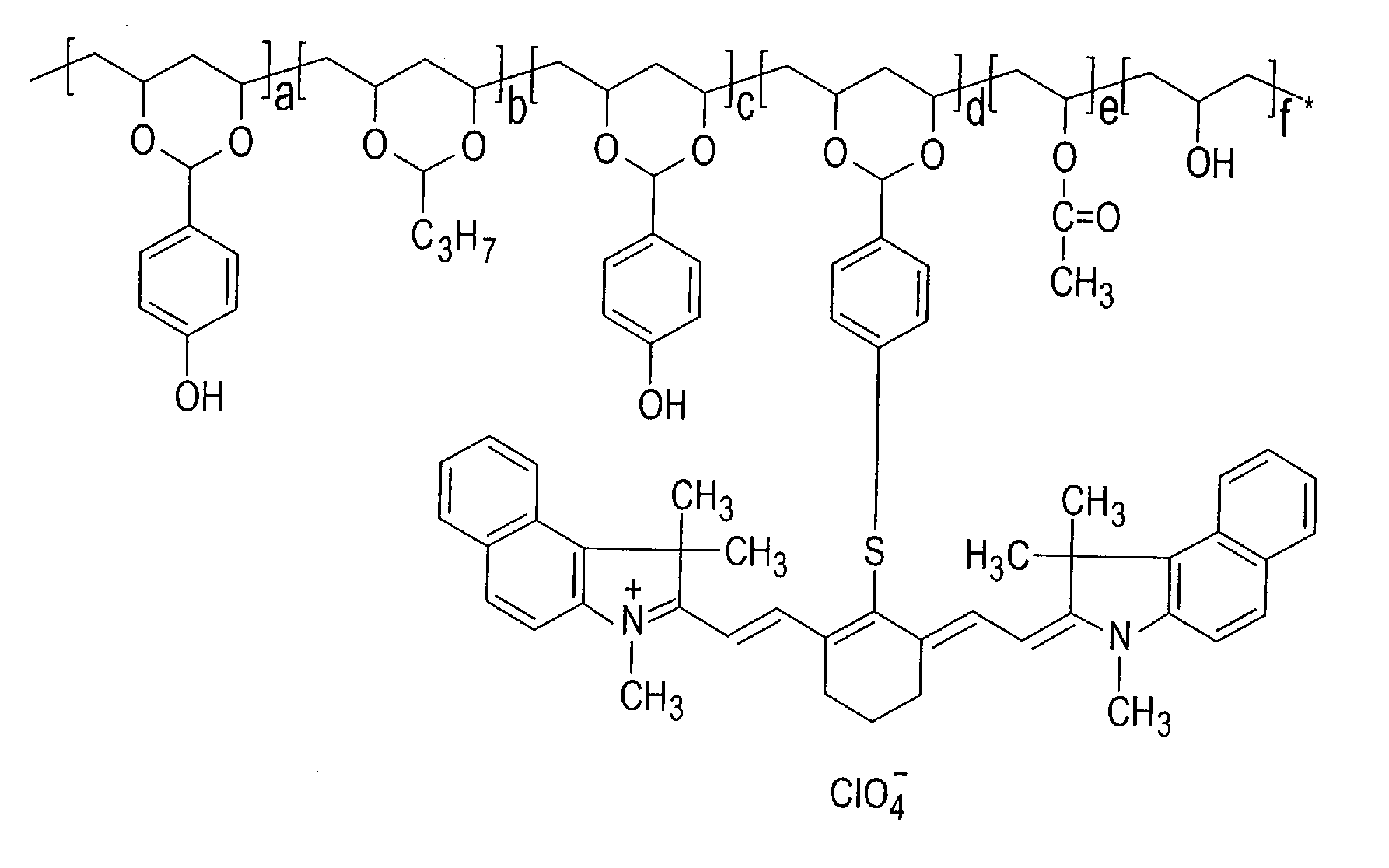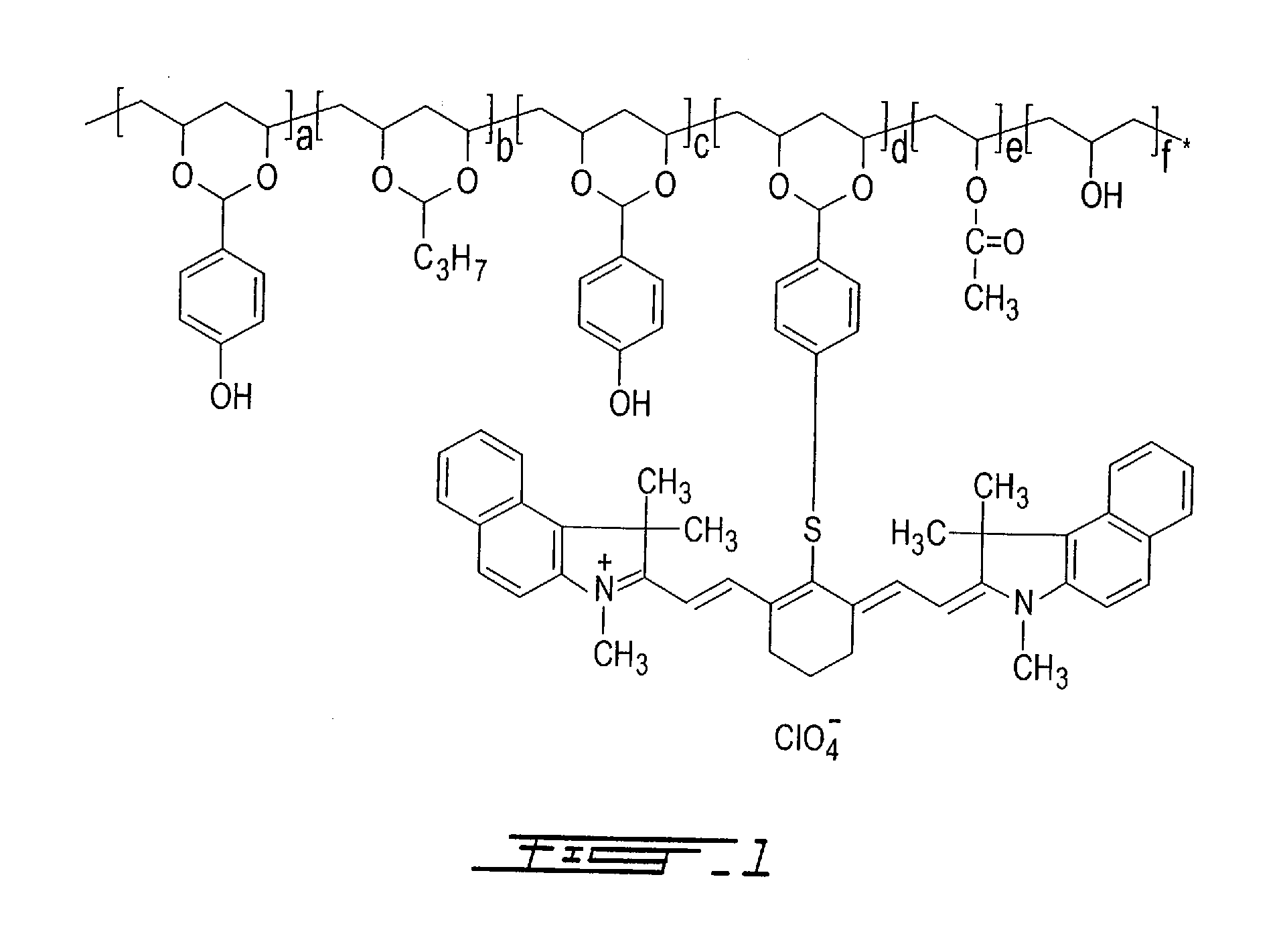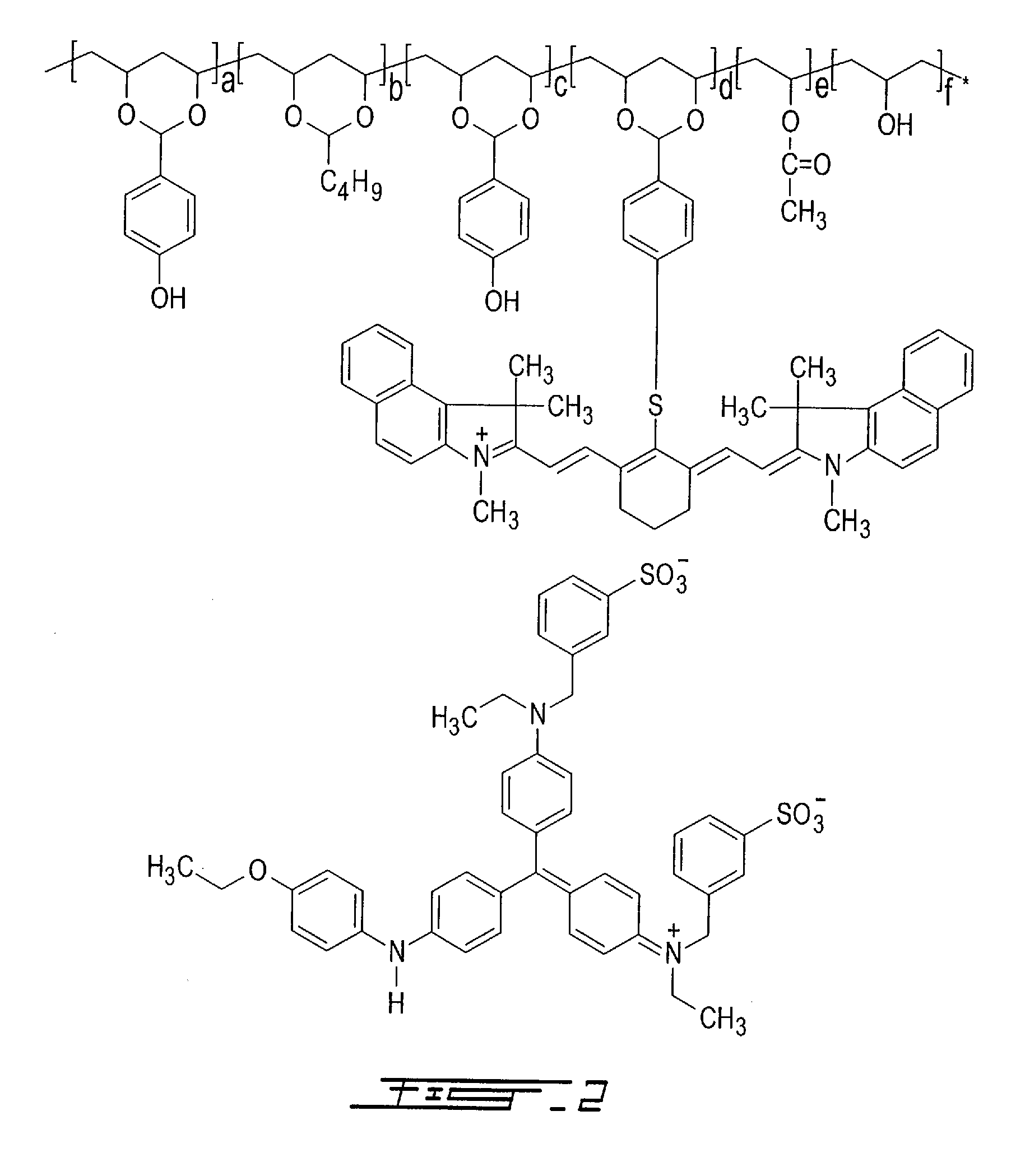Thermally reactive near-infrared absorbing acetal copolymers, methods of preparation and methods of use
a technology of acetal copolymer and near-infrared absorption, which is applied in the field of new acetal copolymer, can solve the problems of poor image quality, difficult to remove the laser-exposed area with liquid developer, and difficult to process lithographic printing plates
- Summary
- Abstract
- Description
- Claims
- Application Information
AI Technical Summary
Problems solved by technology
Method used
Image
Examples
example 1
[0121] Copolymer M1-S01 was synthesized by adding, by portions, 90 grams of polyvinyl alcohol (Celvol™ 103, an 98% hydrolyzed polyvinyl acetate having an average molecular weight of about 18,000) to a reaction flask containing 810 grams of dimethylsulfoxide (DMSO) at 60° C., under nitrogen atmosphere and with constant stirring. After complete dissolution, 3 ml of concentrated sulfuric acid, which acts as a catalyst for this reaction, were added to the flask. After thirty minutes, 25 grams of butyraldehyde (346.6 mmole, available from Sigma-Aldrich, Canada) were slowly added to the flask and the mixture was stirred at 60° C. for 2 hours. Then, 61 grams of 4-hydroxybenzaldehyde (499.5 mmole, available from Sigma-Aldrich, Canada) were slowly added to the flask and the mixture was stirred at 60° C. for 4 hours. Finally, a solution containing 100 ml of 1-methoxypropanol and 20 grams of 2-[2-[2-(4-formylbenzothio)-3-(1,3-dihydro-1,3,3-trimethyl-2H-benz[e]indol-2-ylidene)-ethylidene]-1-cyc...
example 2
[0123] Copolymer M1-S02 was synthesized by adding, by portions, 90 grams of polyvinyl alcohol (Celvol™ 103, an 98% hydrolyzed polyvinyl acetate having an average molecular weight of about 18,000) to a reaction flask containing 810 grams of DMSO at 60° C. under nitrogen atmosphere and with constant stirring. After complete dissolution, 3 ml of concentrated sulfuric acid were added to the flask. After thirty minutes, 25 grams of butyraldehyde (346.6 mmole, available from Sigma-Aldrich, Canada) were slowly added to the flask and the mixture was stirred at 60° C. for 2 hours. Then, 61 grams of 4-hydroxybenzaldehyde (499.5 mmole, available from Sigma-Aldrich, Canada) were slowly added to the flask and the mixture was stirred at 60° C. for 4 hours. Then, a solution containing 100 ml of 1-methoxypropanol and 20 grams of 2-[2-[2-(4-formylbenzothio)-3-(1,3-dihydro-1,3,3-trimethyl-2H-benz[e]indol-2-ylidene)-ethylidene]-1-cyclohexen-1-yl]-ethenyl]-1,3,3-trimethyl-1H-benz[e]indolium perchlorate...
example 3
[0125] Copolymer M1-S03 was synthesized in a way very similar to that of the M1-S01 near-infrared absorbing polymer described in Example 1. The only difference was that 23.1 grams of 2-[2-[2-[4-(4-formylphenylcarboxamido)benzothio]-3-[1,3-dihydro-1,3,3-trimethyl-2H-benz[e]indol-2-ylidene)-ethylidene]-1-cyclohexen-1-yl]-ethenyl]-1,3,3-trimethyl-1H-benz[e]indolium perchlorate (25.5 mmole, available from American Dye Source, Inc.) were used instead of the 20 grams of 2-[2-[2-(4-formylbenzothio)-3-(1,3-dihydro-1,3,3-trimethyl-2H-benz[e]indol-2-ylidene)-ethylidene]-1-cyclohexen-1-yl]-ethenyl]-1,3,3-trimethyl-1H-benz[e]indolium perchlorate that were used in Example 1. The dark green product obtained was precipitated in 10 liters of de-ionized water, filtered and washed copiously with water. It was then dried in air until constant weight.
[0126] The UV-Vis-NIR spectrum of M1-S03 was recorded in methanol and exhibited a strong near-infrared absorption peak at 825 nm. The ideal structure of ...
PUM
| Property | Measurement | Unit |
|---|---|---|
| temperature | aaaaa | aaaaa |
| temperature | aaaaa | aaaaa |
| weight | aaaaa | aaaaa |
Abstract
Description
Claims
Application Information
 Login to View More
Login to View More - R&D
- Intellectual Property
- Life Sciences
- Materials
- Tech Scout
- Unparalleled Data Quality
- Higher Quality Content
- 60% Fewer Hallucinations
Browse by: Latest US Patents, China's latest patents, Technical Efficacy Thesaurus, Application Domain, Technology Topic, Popular Technical Reports.
© 2025 PatSnap. All rights reserved.Legal|Privacy policy|Modern Slavery Act Transparency Statement|Sitemap|About US| Contact US: help@patsnap.com



